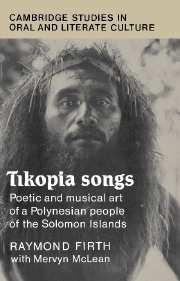Book contents
- Frontmatter
- Contents
- ILLUSTRATIONS
- FIGURES
- Preface
- Acknowledgements
- Sketch map of Tikopia (approx. 5 sq. km.)
- Part I General
- Part II Musical analysis (by Mervyn McLean)
- Part III Song texts, translations and commentary
- 6 Dance songs of everyday life
- 7 Songs of the sea and of travel
- 8 Eulogies and farewells
- 9 Songs of protest and criticism
- 10 Songs of erotic arousal and sex antagonism
- 11 Laments and funeral dirges
- 12 Songs on historical and mythic themes, and of ritual quality
- 13 Epilogue
- Appendix 1 Composers to whom songs attributed
- References
- Index
10 - Songs of erotic arousal and sex antagonism
Published online by Cambridge University Press: 07 May 2010
- Frontmatter
- Contents
- ILLUSTRATIONS
- FIGURES
- Preface
- Acknowledgements
- Sketch map of Tikopia (approx. 5 sq. km.)
- Part I General
- Part II Musical analysis (by Mervyn McLean)
- Part III Song texts, translations and commentary
- 6 Dance songs of everyday life
- 7 Songs of the sea and of travel
- 8 Eulogies and farewells
- 9 Songs of protest and criticism
- 10 Songs of erotic arousal and sex antagonism
- 11 Laments and funeral dirges
- 12 Songs on historical and mythic themes, and of ritual quality
- 13 Epilogue
- Appendix 1 Composers to whom songs attributed
- References
- Index
Summary
Tikopia poetic art is almost entirely without love songs. This is not for want of strong attraction between man and woman or of articulate pleading for the sexual favour and the affection of someone of the other sex. Small gifts, such as portions of tobacco or areca nut, reinforce the expression of desire. But the Tikopia cultural idiom did not take a form of songs praising the qualities of the beloved, and very rarely expressed affection and longing for the person of the other.
Tikopia songs in the field of sex relations tend to assume what may be called an adversarial rather than a conjunctive form. To understand how this may have come to be so needs some knowledge of the Tikopia attitude to marriage and the categories involved.
Of prime importance to the life of Tikopia young people is the division between the married and the unmarried. Marriage has traditionally marked a clearcut break in the social life. The unmarried consist of two sets of socially identified people - bachelor men and youths (nga tamāroa) and spinster women and girls (nga fāfine taka). Together they make up the most active social component of the Tikopia population in the recreational sphere. In small bands or in large groups they play games together, they go around from one village to another in search of amusement, and above all, they are the backbone of the dance.
- Type
- Chapter
- Information
- Tikopia SongsPoetic and Musical Art of a Polynesian People of the Solomon Islands, pp. 205 - 233Publisher: Cambridge University PressPrint publication year: 1991



